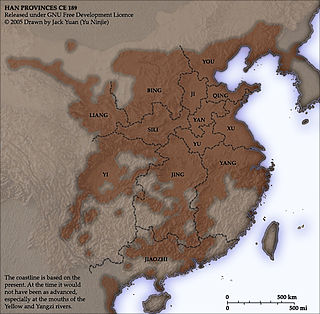The history of the administrative divisions of the Imperial China is quite complex. Across history, what is called 'China' has taken many shapes, and many political organizations. For various reasons, both the borders and names of political divisions have changed—sometimes to follow topography, sometimes to weaken former states by dividing them, and sometimes to realize a philosophical or historical ideal. For recent times, the number of recorded tiny changes is quite large; by contrast, the lack of clear, trustworthy data for ancient times forces historians and geographers to draw approximate borders for respective divisions. But thanks to imperial records and geographic descriptions, political divisions may often be redrawn with some precision. Natural changes, such as changes in a river's course, or loss of data, still make this issue difficult for ancient times.

Linxia Hui Autonomous Prefecture formerly known as Hezhou is located in Gansu province, south of the provincial capital Lanzhou, bordering Qinghai to the west. It is an autonomous prefecture for the Muslim Hui people, a large Chinese ethnic group. It also includes two autonomous counties for other Muslim groups, namely Dongxiang, Salar, and Bonan.

Gānnán Tibetan Autonomous Prefecture is an autonomous prefecture in southern Gansu Province, China. It includes Xiahe and the Labrang Monastery, Luqu, Maqu, and other mostly Tibetan towns and villages. Gannan has an area of 40,898 km2 (15,791 sq mi) and its capital is Hezuo (Zoi). In the first year of the proclamation of Gannan Autonomous District, the district-seat was at the Labrang Town of Sangqu.
Autonomous prefectures are one type of autonomous administrative divisions of China, existing at the prefectural level, with either ethnic minorities forming over 50% of the population or being the historic home of significant minorities. All autonomous prefectures are mostly dominated, in population, by the Han Chinese. The official name of an autonomous prefecture includes the most dominant minority in that region, sometimes two, rarely three. For example, a Kazakh prefecture may be called Kazak Zizhizhou. Like all other prefectural level divisions, autonomous prefectures are divided into county level divisions. There is one exception: Ili Kazak Autonomous Prefecture contains two prefectures of its own. Under the Constitution of the People's Republic of China, autonomous prefectures cannot be abolished.
Weizhou or Wei Zhou may refer to:

Yuzhong County (榆中县) is an administrative district in Gansu, the People's Republic of China. It is one of 58 counties of Gansu. It is part of the Lanzhou prefecture, with the city of the same name being the prefecture seat. Its postal code is 730100, and its population in 1999 was 423,336 people.
Jingzhou is a prefecture-level city in Hubei, China
The Amdolese language is the Tibetic language spoken by the majority of Amdolese, mainly in Qinghai and some parts of Sichuan and Gansu.
Xinning is the atonal pinyin romanization of various Chinese words and names, particularly Xīnníng.
Zhang Yichao was a Han Chinese resident of Sha Prefecture. When the Tibetan Empire plunged into civil war, he led a rebellion, capturing several cities and reverted the area's allegiance to the Tang Dynasty. He subsequently conquered the Hexi Corridor and governed it as the military commissioner (Jiedushi) of Guiyi Circuit under nominal authority of the Tang emperors.

The Lianyungang–Khorgas Expressway, commonly referred to as the Lianhuo Expressway, is 4,243-kilometre-long expressway (2,636 mi) in the People's Republic of China that connects the cities of Lianyungang, in the province of Jiangsu, and Khorgas, in the autonomous region of Xinjiang, on the border with Kazakhstan. At Khorgas, there is a border crossing into Kazakhstan. The expressway is the longest contiguous expressway in China with a single numeric designation, stretching across the country from the Yellow Sea on the east coast to the Kazakhstan border in the west. It passes through the provinces of Jiangsu, Anhui, Henan, Shaanxi, Gansu, and Xinjiang.
Fengzhou or Feng Prefecture (鳳州) was a zhou (prefecture) in imperial China, centering on modern Feng County, Shaanxi, China. It was created in 554 by Western Wei and existed (intermittently) until 1374 during the Ming dynasty.
Jingzhou or Jing Prefecture (涇州) was a zhou (prefecture) in imperial China, centering on modern Jingchuan County, Gansu, China. It was created in the 5th century by Northern Wei and existed (intermittently) until 1913 after the establishment of the Republic of China.
Qingzhou or Qing Prefecture (慶州) was a zhou (prefecture) in imperial China centering on modern Qingyang in Gansu, China. It existed (intermittently) from 596 to 1125.
Jiezhou or Jie Prefecture (階州) was a zhou (prefecture) in imperial China in modern Longnan, Gansu, China. It existed (intermittently) from 892 to 1913.
Weizhou or Wei Prefecture was a zhou (prefecture) in imperial China centering on modern Pingliang, Gansu, China. It existed (intermittently) from 809 until the 12th century when the Jin dynasty conquered the area from the Song dynasty.












